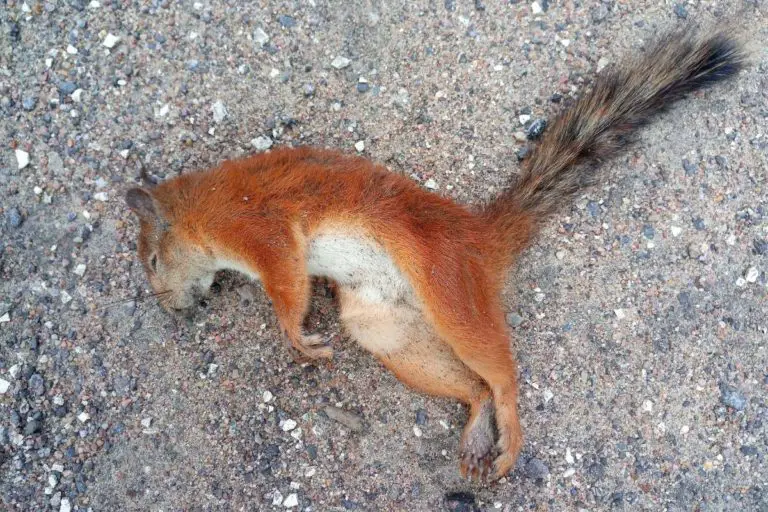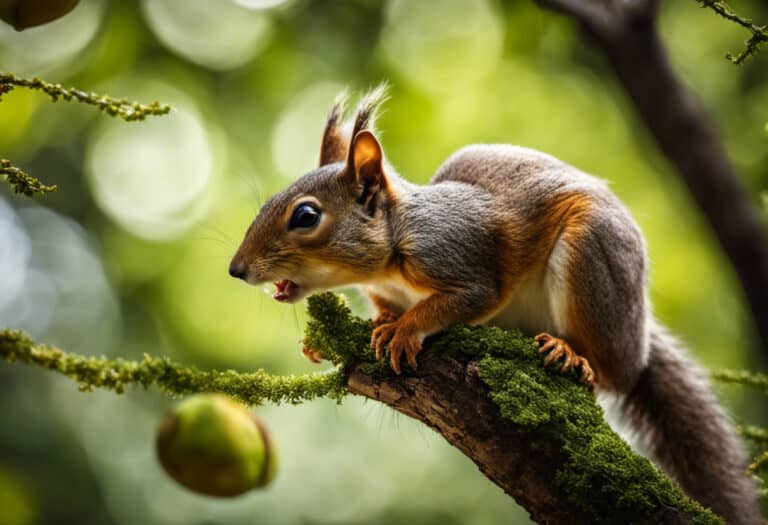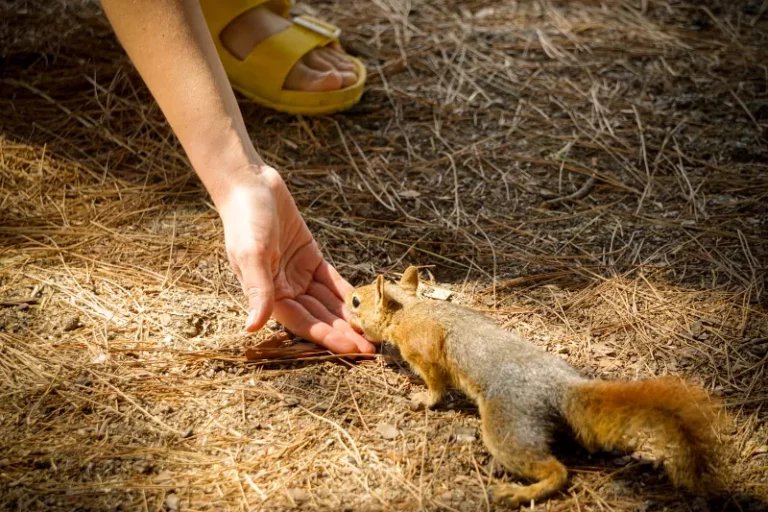How to Take Care of an Injured Squirrel
You might be thinking, ‘Why would I want to take care of an injured squirrel?’ Well, let me tell you, these little creatures need our help when they’re hurt. Whether it’s a broken leg or a wounded wing, knowing how to provide immediate first aid and create a safe space for them can make all the difference.
In this article, we’ll guide you through the steps of recognizing an injured squirrel, assessing the severity of the injury, and providing the care they need to recover and thrive.
So let’s get started and lend a helping hand to our furry friends.
Key Takeaways
- Observe the squirrel’s behavior and assess for injury
- Provide a warm and quiet space for the squirrel to rest
- Offer a balanced diet suitable for squirrels and provide fresh water
- Gradually reintroduce the squirrel to the outdoors and monitor its progress and recovery
Recognizing an Injured Squirrel
You should first look for signs of an injured squirrel, such as limping or visible wounds. When you come across a squirrel that seems injured, it is important to assess the situation carefully.
Approach the squirrel calmly and observe its behavior. Is it moving slowly or unable to move at all? Does it seem disoriented or in pain? Take note of any visible wounds or blood.
If the squirrel appears to be in distress, it is crucial to contact wildlife rehabilitators immediately. They have the necessary experience and resources to provide proper care for injured squirrels.
Avoid handling the squirrel yourself, as this can cause further harm or stress to the animal.
Assessing the Severity of the Injury
When caring for an injured squirrel, it’s important to first assess the severity of its injuries. Look for visible signs such as bleeding, limping, or open wounds, which may indicate a more serious condition.
Remember to handle the injured squirrel gently and with care, as it may be frightened or in pain.
If you’re unsure about the severity of the injuries or how to properly care for the squirrel, it’s always best to seek professional veterinary help to ensure the squirrel receives the appropriate treatment and care it needs.
Visible Signs of Injury
There’s no need to panic if you notice visible signs of injury on the squirrel. It’s important to remain calm and approach the situation with care.
Recognizing hidden injuries is crucial in providing proper care for injured squirrels. Look for obvious signs such as bleeding, limping, or visible wounds. If you see any of these, it’s important to handle the squirrel gently and avoid causing further harm. Assess the severity of the injury and determine if immediate medical attention is required.
If the injury appears minor, you can provide temporary care by creating a warm and quiet environment for the squirrel. Remember to contact a local wildlife rehabilitator for guidance and assistance in providing the best possible care for the injured squirrel.
Handling the Injured Squirrel
If the squirrel is injured, it’s important to handle it gently and avoid causing further harm. Remember, squirrels are fragile creatures, and they may bite or scratch out of fear and pain.
Here are some tips for handling an injured squirrel:
-
Restraining Techniques:
-
Use a towel or a thick cloth to gently cover the squirrel, providing a sense of security and reducing the chances of it escaping.
-
If necessary, wear thick gloves to protect yourself from potential bites or scratches.
-
Calming Techniques:
-
Speak softly and calmly to the squirrel to help soothe its anxiety.
-
Keep the squirrel in a quiet and dimly lit area to minimize stress and provide a calm environment.
Seeking Professional Veterinary Help
It’s important to contact a wildlife rehabilitator or veterinarian as soon as possible for professional help with an injured squirrel.
When you come across an injured squirrel, it’s crucial to seek veterinary assistance or contact a wildlife rehabilitation center. These professionals have the knowledge and experience to provide the necessary care for the squirrel’s injuries.
A veterinarian can assess the squirrel’s condition and provide appropriate medical treatment. They may administer pain relief, clean wounds, and administer antibiotics if necessary.
Wildlife rehabilitators specialize in treating and rehabilitating injured animals, including squirrels. They can provide a safe and suitable environment for the squirrel to recover. Additionally, they have the expertise to handle the unique needs of wildlife and ensure they are released back into their natural habitat once they have fully recovered.
Seeking professional veterinary help is essential for the well-being and successful rehabilitation of an injured squirrel.
Safety Precautions Before Approaching an Injured Squirrel
To ensure your safety before approaching an injured squirrel, remember to wear protective gloves and make sure you are in a calm and quiet environment. This will not only protect you from potential scratches or bites but also prevent infections that the squirrel might carry. Here are some additional safety precautions to consider:
-
Minimizing Stress: Injured squirrels are already in a vulnerable state, so it’s important to approach them with care and minimize any additional stress. Speak softly and move slowly to avoid startling the squirrel. Keep any loud noises or sudden movements to a minimum.
-
Preventing Infections: Infections can pose a serious threat to both you and the squirrel. Avoid direct contact with the squirrel’s blood, saliva, or any open wounds. Wash your hands thoroughly with soap and water after handling the squirrel.
Providing Immediate First Aid
Now that you’ve taken necessary safety precautions, it’s important to assess the squirrel’s injuries before providing immediate first aid.
Start by carefully examining the squirrel for any visible wounds or signs of bleeding.
If you notice any broken bones, it’s crucial to stabilize them to prevent further harm.
Remember to treat wounds and bleeding promptly and gently to minimize pain and the risk of infection.
Assessing the Squirrel’s Injuries
First, you’ll need to gently examine the squirrel’s injuries to determine the best course of action. Start by assessing the squirrel’s pain level. Look for signs of distress such as limping, whimpering, or aggressive behavior. Keep in mind that squirrels are small and fragile creatures, so handle them with care.
Here’s how to proceed:
-
Observe the squirrel from a safe distance before approaching it. This will help you gauge its behavior and level of pain.
-
Once you’re close enough, use a soft cloth or towel to gently pick up the squirrel, supporting its body and avoiding any pressure on the injured areas.
-
Examine the squirrel’s body carefully, checking for any visible wounds, broken bones, or bleeding. Use a magnifying glass if needed to get a better view.
-
Assess the squirrel’s movements. Does it have difficulty climbing or walking? Is it holding its limbs in an abnormal position?
-
Watch for any signs of infection, such as pus or swelling around the wounds.
Stabilizing Broken Bones
Once you’ve assessed the squirrel’s injuries, you’ll need to determine how to stabilize any broken bones. Broken bones can cause immense pain and discomfort for the little squirrel, so it’s crucial to provide proper support and pain management.
One effective way to stabilize broken bones is by using splinting techniques. Begin by carefully immobilizing the injured limb with a padded splint. You can use materials such as popsicle sticks or tongue depressors as the splint. Gently secure the splint to the limb using medical bandages or strips of cloth, making sure not to apply too much pressure. This will help prevent further damage and allow the bone to heal properly.
Additionally, consider providing pain management for the squirrel, such as administering appropriate pain medication under the guidance of a veterinarian.
Treating Wounds and Bleeding
To treat wounds and bleeding, it’s important to clean the affected area gently with mild soap and warm water. This helps to remove any dirt or debris that may be present.
After cleaning the wound, you can apply an antibacterial ointment to prevent infection.
It’s crucial to stop the bleeding as soon as possible. You can do this by applying gentle pressure to the wound using a clean cloth or gauze pad. If the bleeding doesn’t stop after a few minutes, you may need to apply additional pressure or elevate the affected limb.
Remember to keep the injured squirrel calm and comfortable throughout the process.
If the wound is deep or appears to be infected, it’s best to seek veterinary care for proper treatment.
Creating a Safe and Comfortable Space for the Squirrel
Creating a safe and comfortable space for the injured squirrel involves providing a cozy nest and ensuring it has access to food and water.
To create a suitable environment, find a small, quiet area away from predators and loud noises. Line the nest with soft materials like leaves, grass, or shredded paper to keep the squirrel warm and comfortable. Place the nest in a sturdy box or cage with proper ventilation. Remember to check the nest regularly for cleanliness and replace soiled bedding.
In addition to physical comfort, mental stimulation is important for the squirrel’s well-being. Provide toys like branches or chewable objects to keep the squirrel entertained and prevent boredom.
Feeding an Injured Squirrel
Feeding the injured squirrel involves providing a balanced diet of nuts, fruits, and vegetables to ensure its nutritional needs are met. During the rehabilitation process, it is crucial to understand the squirrel’s dietary requirements. Here are some key points to consider:
-
Nuts: Offer a variety of nuts such as walnuts, almonds, and hazelnuts. These are a great source of protein and healthy fats, essential for the squirrel’s recovery.
-
Fruits: Provide a mix of fresh fruits like apples, berries, and grapes. These provide vitamins and antioxidants, helping to boost the squirrel’s immune system. Tip: Avoid citrus fruits as they may cause stomach upset.
-
Vegetables: Offer leafy greens like spinach and kale, as well as carrots and sweet potatoes. These provide essential vitamins and minerals, aiding in the squirrel’s overall well-being. Tip: Ensure the vegetables are finely chopped or grated for easier consumption.
Monitoring the Squirrel’s Progress
Monitoring the squirrel’s progress includes regularly observing its behavior, noting any changes in appetite or movement, and documenting its overall recovery. Evaluating the squirrel’s progress is crucial to ensure its successful rehabilitation.
Start by observing the squirrel’s behavior. Is it moving around more or less? Is it showing signs of pain or discomfort? Any changes in appetite or eating habits should also be noted. Is the squirrel eating enough? Is it showing interest in food?
Documenting the overall recovery involves keeping track of any improvements or setbacks. Are there any visible signs of healing? Is the squirrel gaining weight?
Monitoring the squirrel’s progress allows you to make informed decisions about its care and adjust the treatment plan accordingly. Be patient and compassionate as you guide the squirrel towards a full recovery.
Seeking Professional Help and Rehabilitation Options
If you’re unsure about the best course of action, it’s recommended to seek professional help and explore different rehabilitation options for the injured squirrel. Rehabilitation methods and long-term care options can greatly improve the squirrel’s chances of recovery and survival.
Here are some steps you can take:
-
Consult with a licensed wildlife rehabilitator or a veterinarian experienced in treating small mammals. They can assess the squirrel’s condition and provide guidance on the best course of action.
-
Consider options for rehabilitation, such as temporary care in a wildlife rehabilitation center or long-term care in a licensed wildlife sanctuary.
-
Wildlife rehabilitation centers can provide specialized care, including medical treatment, proper nutrition, and socialization with other squirrels.
-
Wildlife sanctuaries offer a more permanent solution for squirrels that cannot be released back into the wild due to severe injuries or disabilities.
Releasing the Squirrel Back Into the Wild
Once the squirrel has completed its rehabilitation and is deemed healthy and capable, it can be safely released back into its natural habitat. The rehabilitation process for injured squirrels involves providing them with medical treatment, a nurturing environment, and gradual reintroduction to the wild. This ensures that they regain their strength, agility, and survival skills before returning to their natural habitat.
When it comes to releasing the squirrel back into the wild, certain factors need to be considered. The table below outlines the important steps involved in the release process:
| Step | Description |
|---|---|
| 1 | Choose an appropriate release site that meets the squirrel’s habitat requirements. |
| 2 | Ensure that the release site is free from any potential threats or dangers. |
| 3 | Gradually introduce the squirrel to its new environment, allowing it time to adjust and explore before fully releasing it. |
Releasing the squirrel back into the wild is a crucial step in its rehabilitation journey. It gives the squirrel a chance to resume its natural behaviors and contribute to the ecosystem once again. It is important to monitor the squirrel’s progress after release to ensure its successful transition back into the wild.
Frequently Asked Questions
Can I Keep the Injured Squirrel as a Pet?
You shouldn’t keep an injured squirrel as a pet without considering their recovery and care needs. It’s important to seek professional help or follow home remedies for their improvement. Also, be aware of legal restrictions and permits for releasing them.
How Long Does It Take for an Injured Squirrel to Recover?
The rehabilitation process for an injured squirrel can vary depending on the severity of their injuries. Common injuries include broken bones, wounds, and dehydration. Recovery time can range from weeks to months.
Can I Use Home Remedies Instead of Seeking Professional Help?
You might be wondering if you can use home remedies instead of seeking professional help for an injured squirrel. While there are alternatives, it’s important to consider the severity of the injury and the expertise of a professional.
What Should I Do if the Injured Squirrel Doesn’t Seem to Be Improving?
If the injured squirrel doesn’t seem to be improving, it’s important to seek professional help. They have the expertise to provide the necessary care and evaluate if alternative treatments are needed. Don’t hesitate to get the help your squirrel needs.
Are There Any Legal Restrictions or Permits Required When Releasing a Squirrel Back Into the Wild?
When it’s time to release an injured squirrel back into the wild, keep in mind legal restrictions and permit requirements. Ensure the squirrel is ready and find a safe, suitable location for its return.
Conclusion
In conclusion, taking care of an injured squirrel requires careful attention and compassion. Remember to prioritize safety and assess the severity of the injury before providing immediate first aid.
It is fascinating to note that according to a study conducted by wildlife rehabilitation centers, over 80% of injured squirrels successfully recover and are released back into the wild.
Imagine the joy of witnessing a once-injured squirrel happily scampering through the trees, thanks to your dedication and care.






